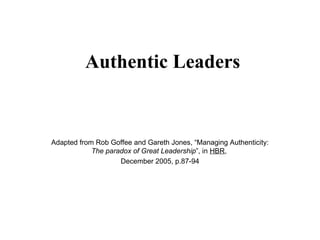Authentic Leaders
•Télécharger en tant que PPT, PDF•
3 j'aime•1,346 vues
Signaler
Partager
Signaler
Partager

Recommandé
Contenu connexe
Tendances
Tendances (20)
Discovering Your Authentic Leadership by Dr. Yasmin Davidds

Discovering Your Authentic Leadership by Dr. Yasmin Davidds
En vedette
En vedette (20)
Setting Priorities in Life, A Story about Life Eqauls to a Jar

Setting Priorities in Life, A Story about Life Eqauls to a Jar
Similaire à Authentic Leaders
Similaire à Authentic Leaders (20)
2-SOCIAL-RELATIONSHIPS-OF-MIDDLE-AND-LATE-ADOLESCENCE.ppt

2-SOCIAL-RELATIONSHIPS-OF-MIDDLE-AND-LATE-ADOLESCENCE.ppt
Harnessing Your True Identity for Effortless Influence

Harnessing Your True Identity for Effortless Influence
Dernier
Dernier (20)
Pre Engineered Building Manufacturers Hyderabad.pptx

Pre Engineered Building Manufacturers Hyderabad.pptx
Over the Top (OTT) Market Size & Growth Outlook 2024-2030

Over the Top (OTT) Market Size & Growth Outlook 2024-2030
The Abortion pills for sale in Qatar@Doha [+27737758557] []Deira Dubai Kuwait![The Abortion pills for sale in Qatar@Doha [+27737758557] []Deira Dubai Kuwait](data:image/gif;base64,R0lGODlhAQABAIAAAAAAAP///yH5BAEAAAAALAAAAAABAAEAAAIBRAA7)
![The Abortion pills for sale in Qatar@Doha [+27737758557] []Deira Dubai Kuwait](data:image/gif;base64,R0lGODlhAQABAIAAAAAAAP///yH5BAEAAAAALAAAAAABAAEAAAIBRAA7)
The Abortion pills for sale in Qatar@Doha [+27737758557] []Deira Dubai Kuwait
Call 7737669865 Vadodara Call Girls Service at your Door Step Available All Time

Call 7737669865 Vadodara Call Girls Service at your Door Step Available All Time
New 2024 Cannabis Edibles Investor Pitch Deck Template

New 2024 Cannabis Edibles Investor Pitch Deck Template
Falcon Invoice Discounting: Tailored Financial Wings

Falcon Invoice Discounting: Tailored Financial Wings
How to Get Started in Social Media for Art League City

How to Get Started in Social Media for Art League City
Falcon Invoice Discounting: Unlock Your Business Potential

Falcon Invoice Discounting: Unlock Your Business Potential
SEO Case Study: How I Increased SEO Traffic & Ranking by 50-60% in 6 Months

SEO Case Study: How I Increased SEO Traffic & Ranking by 50-60% in 6 Months
Falcon Invoice Discounting: Empowering Your Business Growth

Falcon Invoice Discounting: Empowering Your Business Growth
Uneak White's Personal Brand Exploration Presentation

Uneak White's Personal Brand Exploration Presentation
Rice Manufacturers in India | Shree Krishna Exports

Rice Manufacturers in India | Shree Krishna Exports
Power point presentation on enterprise performance management

Power point presentation on enterprise performance management
Escorts in Nungambakkam Phone 8250092165 Enjoy 24/7 Escort Service Enjoy Your...

Escorts in Nungambakkam Phone 8250092165 Enjoy 24/7 Escort Service Enjoy Your...
Authentic Leaders
- 1. Authentic Leaders Adapted from Rob Goffee and Gareth Jones, “Managing Authenticity: The paradox of Great Leadership ”, in HBR , December 2005, p.87-94
- 2. INTRODUCTION
- 3. To attract followers, a leader has to be many things to many people. The trick is to pull that of, while remaining true to yourself.
- 12. Steps to take to help others perceive you as a authentic leader Involve building up knowledge about your true self and learning more about others
- 16. Know Yourself and Others
- 19. How authentic leaders acquire the attributes
- 24. USE WHERE YOU COME FROM
- 33. “ I speak to everyone in the same way, whether he the garbage man or the president of the university.” Albert Einstein
- 34. CONFORM – BUT ONLY JUST ENOUGH